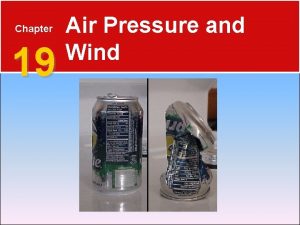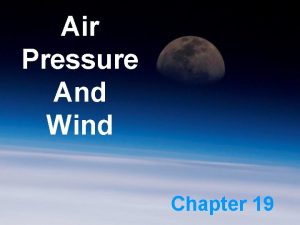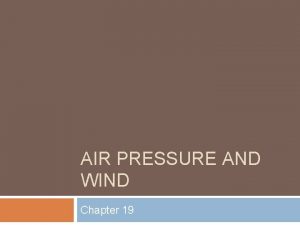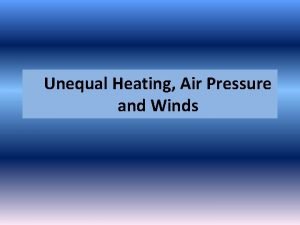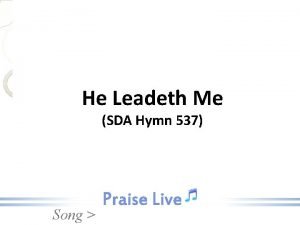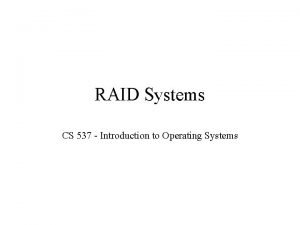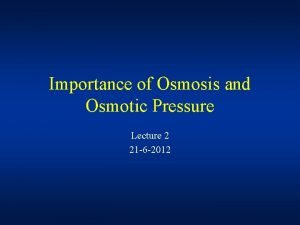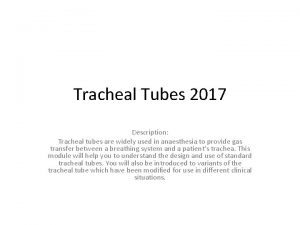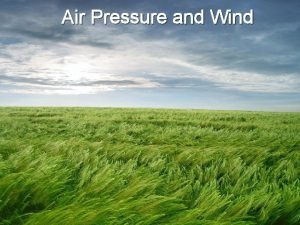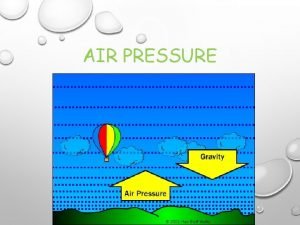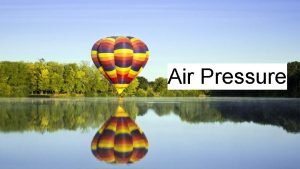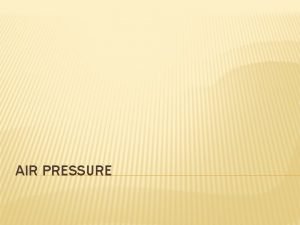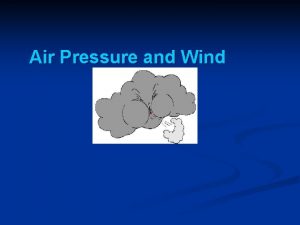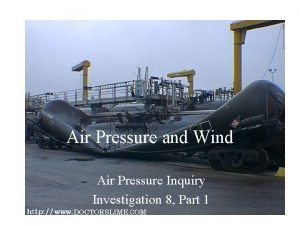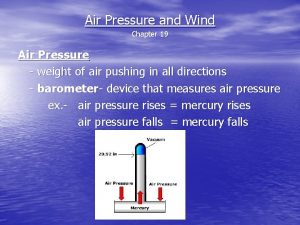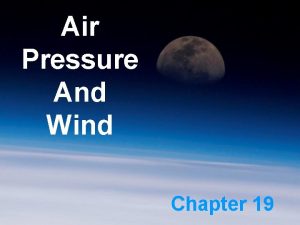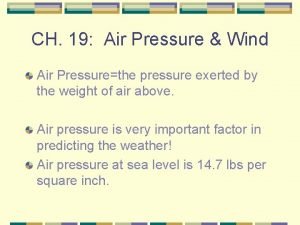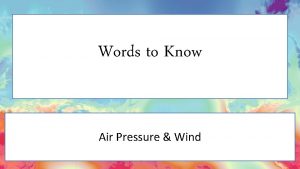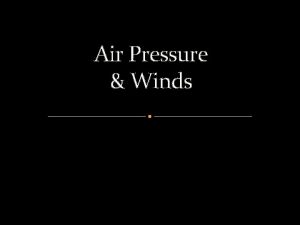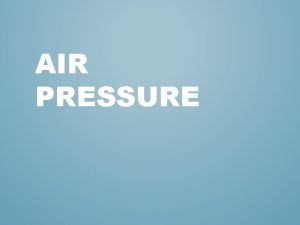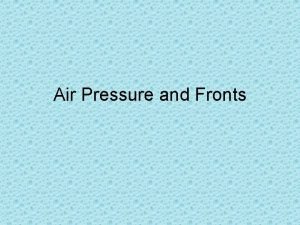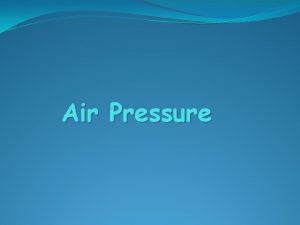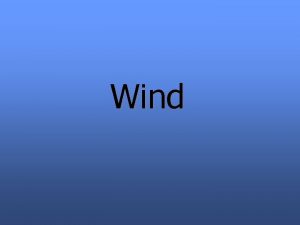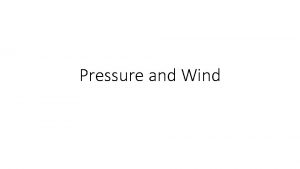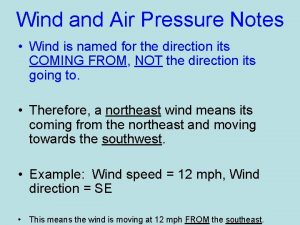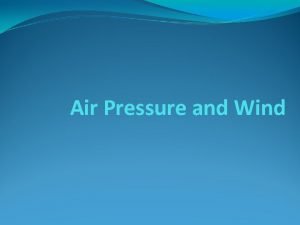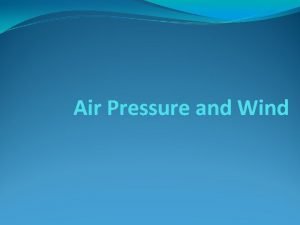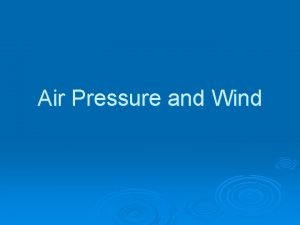Air Pressure and Wind Pages 523 537 WHAT



























- Slides: 27

Air Pressure and Wind Pages 523 -537

WHAT IS AIR PRESSURE? • Air Pressure is the weight of the atmosphere per unit area. • At the surface, the atmospheric pressure is about 1 kg/cm 2

Air Pressure is exerted in all directions

Atmospheric Pressure = Barometric Pressure •

Measuring Air Pressure p 523 • Air pressure is measured with an instrument called a Barometer. • There are two main types of barometers

Measuring Air Pressure p 523 • Aneroid barometer measures the atmospheric pressure using the expansion of a metal.

Measuring Air Pressure p 523 • Mercury barometer measures the atmospheric pressure by adjusting the height of mercury inside a tube.

Air Pressure is measured in millibars p 524 • Millibar is a measure of the actual force of the atmosphere pushing down on a surface. • Standard pressure at sea level is 1013. 2 millibars

Air Pressure decreases with altitude • At higher elevations, there are fewer air molecules above a given surface than a similar surface at lower levels. • An altimeter is an instrument used by air craft to measure height above sea level.

Factors Affecting Air Pressure p 525 • Changing temperature: warm air is lighter than cold air because the molecules of warm air are farther apart. • So when warm air replaces an equal volume of cold air, the air pressure at the ground falls. • Conversely, the arrival of colder air higher up causes the pressure at ground to rise.

Factors affecting Pressure p 525 • Changing humidity: the more water vapor in the air the lighter it is. • When water vapor enters the atmosphere, it pushes out an equal volume of dry air. • Water vapor is lighter than the nitrogen and oxygen it pushes out. Therefore, humid air weighs less than dry air and exerts less pressure.

Pressure indicates weather • High pressure associated with “fair weather” • Low pressure associated with “rain” • Falling pressure associated with increasing cloudiness • Rising pressure associated with clearing conditions

Indicating Pressure • pressure reading in millibars (mb).

Isobars • Isobars are lines that connect areas of equal air pressure. • Pressure Gradient is the spacing between the lines, indicate pressure change over a given distance.

What is the isobar interval on this map? •

What is the isobar interval on this map? • The isobar interval or pressure gradient is 4 millibars.

Cyclones and Anticyclones A cyclone is a large air mass that rotates around a strong center of low atmospheric pressure. • characterized by inward spiraling winds that rotate about a zone of low pressure. • Isobars decrease in value inward indicate a low-pressure center (L) • low pressure in center, spin inward • Effects: heavy rain, strong wind, storms, tornadoes.

Anticyclones • a weather system with high atmospheric pressure at its center, around which air slowly circulates in a clockwise (northern hemisphere) or counterclockwise (southern hemisphere) direction. • Anticyclones are associated with calm, fine weather. • spin outward. • high-pressure center (H) • Associated with calm, fine weather.

What's the difference between cyclone and hurricane or typhoon? • the location where the storm occurs. • same weather phenomenon; • “typhoon” occur in Northwest Pacific • “hurricanes” occur in the Atlantic and Northeast Pacific • “cyclones” occur in the South Pacific and Indian Ocean

Where are the areas of high and low pressures? • Is A an area of high pressure or Low? • B? A B

Practice • Read pages 523 -526 • Answer 1 -5 p 526

Wind Direction and Isobars • Winds flow roughly parallel to the isobars.

How does a barometer work? • Ted Ed • https: //www. youtube. com/watch? v=Ek. Dhlz. A-lw. I

WHAT IS PRESSURE? • Pressure is the amount of Force per unit area.

Example: • What pressure does a 50 kg person exert on the ground when standing on one foot that measures 20 cm x 8 cm? • Pressure = weight/area

Answer: • What pressure does a 50 kg person exert on the ground when standing on one foot that measures 20 cm x 8 cm? • 50 kg/ (20 cmx 8 cm) = 0. 31 kg/cm 2 • What if person is standing on both feet?

Answer: • What pressure does a 50 kg person exert on the ground when standing on one foot that measures 20 cm x 8 cm? • 50 kg/ (20 cmx 8 cm) = 0. 31 kg/cm 2 • What if person is standing on both feet? • Half the pressure: 0. 156 kg/cm 2
 Printed pages vs web pages
Printed pages vs web pages A land breeze usually originates during the
A land breeze usually originates during the Chapter 19 air pressure and wind
Chapter 19 air pressure and wind Air pressure & windwhat is a convection cell?
Air pressure & windwhat is a convection cell? High pressure winds
High pressure winds Barometer
Barometer A swirling center of low air pressure is called
A swirling center of low air pressure is called Sdah 523
Sdah 523 Orf 523
Orf 523 Melike demirbag kaplan
Melike demirbag kaplan Orf523
Orf523 Cs 523
Cs 523 Hymn 523
Hymn 523 523
523 Comp 523 unc
Comp 523 unc Air higroskopis air kapiler dan air gravitasi
Air higroskopis air kapiler dan air gravitasi Wind von backbord weicht wind von steuerbord
Wind von backbord weicht wind von steuerbord Sda hymn 532
Sda hymn 532 Cs537
Cs537 Buddy system memory allocation
Buddy system memory allocation Cs 537
Cs 537 Cs 537
Cs 537 Cs 537
Cs 537 537-317-757
537-317-757 Bernoulli equation mass flow rate
Bernoulli equation mass flow rate Low oncotic pressure
Low oncotic pressure Bevel of et tube
Bevel of et tube High pressure area
High pressure area

